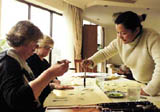 For the past four years, Xu Shuwen, a Shanghai ink and wash painter and, has taught hundreds of local foreigners traditional Chinese painting and calligraphy.
For the past four years, Xu Shuwen, a Shanghai ink and wash painter and, has taught hundreds of local foreigners traditional Chinese painting and calligraphy.
Xu, 26, began to learn Chinese art at the age of four from her father, a man who she said believes in the importance of aesthetic education.
"My father is an art devotee. He loves painting and playing the violin, and often takes me to the operas. He taught me the ink and wash and Chinese calligraphy," Xu said.
"I loved painting so much that I painted all over the walls of my room when I was five," said Xu.
In addition to the teachings of her father, Xu also received instructions from some accomplished painters, such as Lu Yang, Hu Zhenglang and Chen Wuji. After graduating from Shanghai University of the literature major, she became a professional artist at the Huangpu District Art School and her works are exhibited in Japan annually.
"A Japanese man bought one of my paintings, and after he moved to Shanghai his wife wanted to learn Chinese painting from me. She was my first foreign student," said Xu.
At first Xu found it difficult to teach Chinese painting, so she turned to books on education and psychology. Many of her students have never painted before, which made her job even more difficult.
"I got inspiration from children. I discovered that painting done by them is very creative. The color is unique and I can see they have a desire to create because they are not bound by any rules, unlike the adults. So I only teach them the basic brush techniques and ask them not to imitate my work. I want them to paint their own paintings in a happy mood."
To make it easier and more interesting for students to learn Chinese calligraphy, Xu worked out her own method - beginning from the "seal script" where characters look more like pictographs, making it easy to draw.
When students have mastered basic skills, Xu brings them to the Shanghai Museum to see masterpieces in traditional Chinese painting.
"Everything is so beautiful and exciting. Through learning, I know more of Chinese culture," said Mariola Sollander, a Frenchwoman who has brought her mother and two daughters to the class.
"Chinese ink painting is abstract and simple but with a lot of details. However, it is difficult to get it right, either too thick or too thin. And it is challenging to get the right proportions," said Mary Durant, a Canadian woman.
"I love to learn Chinese activities, such as martial arts, tai chi and painting. I think Chinese painting and calligraphy are most difficult for me," said Olivia Codeville, a Frenchwoman.
The roots of Chinese painting can be traced to painted pottery of the Neolithic Age, some 6,000 years ago. Traditional painting, called "guohua" in Chinese, is painted with ink - sometimes with colors - on rice paper or silk.
There are generally two main categories: "xieyi" (freehand strokes) and "gongbi" (elaborate brushwork).
"Xieyi" is characterized by careful control of ink tone, unrestrained brushwork, and no unessential brush strokes. The essence of landscapes, figures and other subjects is rendered with a minimum of expressive ink strokes. By contrast, "gongbi" painting is fine and detailed. The hair on the head or the feathers on a bird's wings are neatly and carefully executed.
In her studio on Huaihai Road, Xu teaches students about the philosophy behind traditional ink-wash painting, and spends a lot of time teaching them the brushwork techniques and spatial relations.
"In my mind no painting is wrong. Just paint things in our life. To me, everything is a painting," Xu said. "I encourage them to draw their favorite things, instead of frustrating them."
Xu has decided to write an English-language book on basic knowledge of Chinese painting and calligraphy, and maybe later open a school.
To be a competent teacher, Xu gets up early every morning to practice her English aloud, read books and make notes for her lessons. "I want to help local foreigners understand the Chinese culture and enjoy their life here," she said.
(Eastday.com 03/14/2001)
